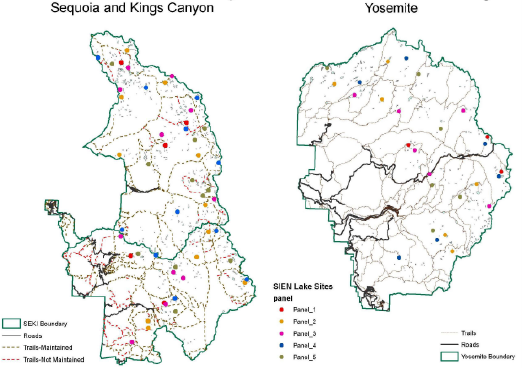Last updated: July 12, 2023
Article
Monitoring Lakes in Sierra Nevada Network Parks

NPS Photo
Background
Sierra Nevada Network (SIEN) parks protect over 1,200 lakes that have some of the highest water quality in the Sierra Nevada. High-elevation lakes are critical components of the parks’ ecosystems, popular visitor destinations, and habitat for aquatic and terrestrial organisms, including declining amphibian species. However, they are subjected to stressors that have the potential to adversely affect them. The stressors with greatest concern are air pollution (e.g., increased nutrient and acid inputs), climate change, non-native invasive species (e.g., fish), and localized visitor impacts. Sierra Nevada lakes are especially sensitive to changes from these stressors because the waters are very dilute and t hus small changes can result in pronounced environmental effects.The Sierra Nevada Network Inventory & Monitoring Program worked closely with SIEN parks to develop and implement the lake monitoring project, initiated in 2008 in Sequoia & Kings Canyon and Yosemite national parks. Network parks selected lake ecosystems were selected for monitoring because they are i) valued for their ecological importance, contribution to wilderness character, recreational opportunities, and importance to regional water supplies, ii) threatened by multiple stressors, iii) sensitive to environmental change, and iv) good indicators of changes within the larger watershed. Monitoring was initiated in 2008 in Sequoia, Kings Canyon, and Yosemite national parks.

in Yosemite National Park.
NPS photo: Dannique Aalbu.
Water Quality and Air Pollution
"Specific information linking water quality issues to regional air quality can have policy implications that are tied to protecting aquatic resources, such as helping establish better air quality regulations."--Andi Heard, SIEN Physical Scientist
The Sierra Nevada Mountains are exposed to air pollution that originates from agricultural, urban, and industrial sources in California’s Central Valley, the San Francisco Bay Area, and as far away as Asia. Nutrients and other pollutants are transported by air currents into the Sierra Nevada where they are deposited on the landscape as wet (through precipitation) and dry deposition (through gases and particles).
The Clean Air Act and Amendments (CAAA), our primary policy for improving air quality and protecting sensitive resources from air pollution, designates Yosemite, Sequoia, and Kings Canyon as Class I Airsheds. This is the highest protection afforded under the CAAA and it prohibits any deterioration of air quality within the parks.
SIEN lake monitoring is designed to detect changes from multiple stressors, however, there is an emphasis on detecting effects from air quality because the parks are in Class I Airsheds and effects from deposition of acids and nutrients are of high concern. Adverse effects from increased acid inputs include decreased ability to buffer further acid inputs and changes in the structure of biotic communities. Increased nutrient inputs are of concern because nutrient availability controls ecosystem productivity through its influence on microbial and phytoplankton growth and changes in nutrient availability are likely to alter ecosystem structure (i.e., numbers and types of species present).
Effects of atmospheric nutrient deposition—a primary Sierra Nevada stressor—on both aquatic and terrestrial habitats, are of high interest to management and science and one of the primary reasons for selecting lakes for monitoring.

Monitoring
The primary goal of SIEN’s lake monitoring program is to determine status and trends in lake water chemistry across the network. SIEN monitors water chemistry at a total of 76 randomly selected lakes that are sampled over a four-year period. Sampling sites are organized in a rotating panel design where eight sites are returned to each year and the remaining 68 are visited on a four year rotation (Figure 1). An additional two “index” sites are monitored more than once within the summer/fall sampling season to provide information on within-season variability in water chemistry.Water chemistry measures include water temperature, pH, specific conductance, dissolved oxygen, acid neutralizing capacity, major anions and cations, particulate carbon, and a suite of nitrogen and phosphorus parameters.
Lake monitoring began in 2008. Field crews monitor SIEN lakes between late July through early October. They backpack to remote wilderness lakes and collect samples at lake outlets for all lakes and also mid-lake by raft for the annually sampled lakes. Samples are filtered on-site, labeled and carefully documented for later lab analyses. Crews also measure water chemistry parameters on-site and conduct shoreline amphibian surveys.
Monitoring results are shared with park staff through annual reports, periodic comprehensive status and trend reports, resource briefs, newsletter articles, seasonal training sessions, and presentations. SIEN’s website provides a project overview and links to related information, the monitoring protocol, and any reports that are available.

Photo: Andi Heard.
Management Applications
Information from the lake monitoring project has a range of management applications. Lake monitoring information:- Is used in resource management planning and reporting efforts, including Natural Resource Condition Assessments, Resource Stewardship Strategies, and Wilderness Stewardship Plans.
- Will assist managers in making informed decisions on the effects of emissions from industrial sources on park resources by providing scientifically credible long-term data.
- Contributes to the protection and restoration of aquatic ecosystems. For example, lake crews discovered and surveyed a previously unknown population of yellow-legged frogs that are now part of Sequoia & Kings Canyon National Parks’ frog restoration efforts.
- Will generate research questions and provide a rich data set that can be a spring board for research projects. A few examples of relevant research topics include critical loads for acid and nutrien deposition, nutrient criteria development, and effects of climate change and changing hydrologic regimes on lake processes.
- Enables parks to evaluate whether lake water quality is in compliance with state standards and to work with other agencies to influence state and federal policies affecting water quality.
More Information
Andi Heard, Physical ScientistSierra Nevada Network
Email: e-mail us
Phone: 559-565-3768
Download Resource Brief.
